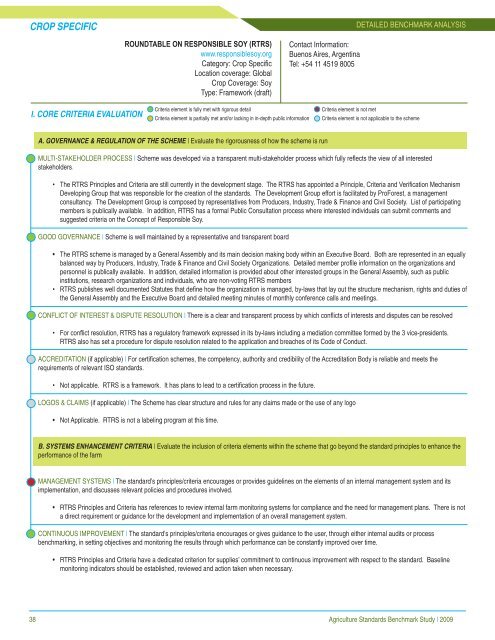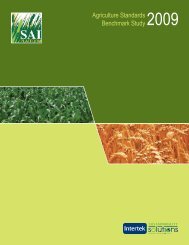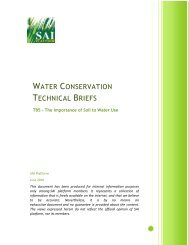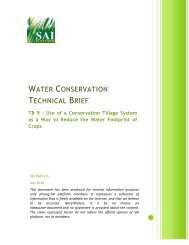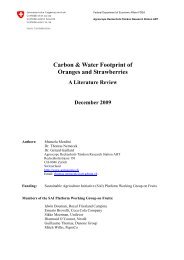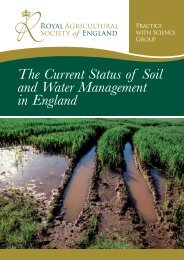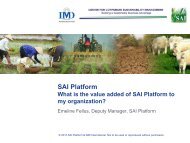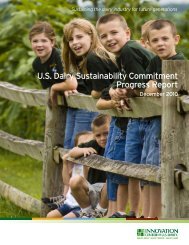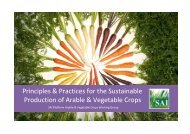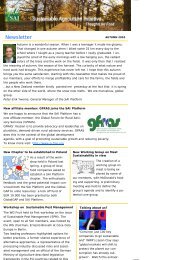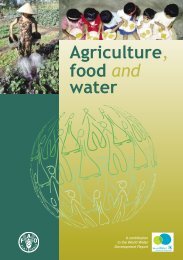DETAILED BENCHMARK ANALYSIS - SAI Platform
DETAILED BENCHMARK ANALYSIS - SAI Platform
DETAILED BENCHMARK ANALYSIS - SAI Platform
You also want an ePaper? Increase the reach of your titles
YUMPU automatically turns print PDFs into web optimized ePapers that Google loves.
CROP SPECIFIC<br />
<strong>DETAILED</strong> <strong>BENCHMARK</strong> <strong>ANALYSIS</strong><br />
ROUNDTABLE ON RESPONSIBLE SOY (RTRS)<br />
www.responsiblesoy.org<br />
Category: Crop Specific<br />
Location coverage: Global<br />
Crop Coverage: Soy<br />
Type: Framework (draft)<br />
Contact Information:<br />
Buenos Aires, Argentina<br />
Tel: +54 11 4519 8005<br />
I. CORE CRITERIA EVALUATION<br />
Criteria element is fully met with rigorous detail<br />
Criteria element is partially met and/or lacking in in-depth public information<br />
Criteria element is not met<br />
Criteria element is not applicable to the scheme<br />
A. GOVERNANCE & REGULATION OF THE SCHEME | Evaluate the rigorousness of how the scheme is run<br />
MULTI-STAKEHOLDER PROCESS | Scheme was developed via a transparent multi-stakeholder process which fully reflects the view of all interested<br />
stakeholders.<br />
• The RTRS Principles and Criteria are still currently in the development stage. The RTRS has appointed a Principle, Criteria and Verification Mechanism<br />
Developing Group that was responsible for the creation of the standards. The Development Group effort is facilitated by ProForest, a management<br />
consultancy. The Development Group is composed by representatives from Producers, Industry, Trade & Finance and Civil Society. List of participating<br />
members is publically available. In addition, RTRS has a formal Public Consultation process where interested individuals can submit comments and<br />
suggested criteria on the Concept of Responsible Soy.<br />
GOOD GOVERNANCE | Scheme is well maintained by a representative and transparent board<br />
• The RTRS scheme is managed by a General Assembly and its main decision making body within an Executive Board. Both are represented in an equally<br />
balanced way by Producers, Industry, Trade & Finance and Civil Society Organizations. Detailed member profile information on the organizations and<br />
personnel is publically available. In addition, detailed information is provided about other interested groups in the General Assembly, such as public<br />
institutions, research organizations and individuals, who are non-voting RTRS members<br />
• RTRS publishes well documented Statutes that define how the organization is managed, by-laws that lay out the structure mechanism, rights and duties of<br />
the General Assembly and the Executive Board and detailed meeting minutes of monthly conference calls and meetings.<br />
CONFLICT OF INTEREST & DISPUTE RESOLUTION | There is a clear and transparent process by which conflicts of interests and disputes can be resolved<br />
• For conflict resolution, RTRS has a regulatory framework expressed in its by-laws including a mediation committee formed by the 3 vice-presidents.<br />
RTRS also has set a procedure for dispute resolution related to the application and breaches of its Code of Conduct.<br />
ACCREDITATION (if applicable) | For certification schemes, the competency, authority and credibility of the Accreditation Body is reliable and meets the<br />
requirements of relevant ISO standards.<br />
• Not applicable. RTRS is a framework. It has plans to lead to a certification process in the future.<br />
LOGOS & CLAIMS (if applicable) | The Scheme has clear structure and rules for any claims made or the use of any logo<br />
• Not Applicable. RTRS is not a labeling program at this time.<br />
B. SYSTEMS ENHANCEMENT CRITERIA | Evaluate the inclusion of criteria elements within the scheme that go beyond the standard principles to enhance the<br />
performance of the farm<br />
MANAGEMENT SYSTEMS | The standard’s principles/criteria encourages or provides guidelines on the elements of an internal management system and its<br />
implementation, and discusses relevant policies and procedures involved.<br />
• RTRS Principles and Criteria has references to review internal farm monitoring systems for compliance and the need for management plans. There is not<br />
a direct requirement or guidance for the development and implementation of an overall management system.<br />
CONTINUOUS IMPROVEMENT | The standard’s principles/criteria encourages or gives guidance to the user, through either internal audits or process<br />
benchmarking, in setting objectives and monitoring the results through which performance can be constantly improved over time.<br />
• RTRS Principles and Criteria have a dedicated criterion for supplies’ commitment to continuous improvement with respect to the standard. Baseline<br />
monitoring indicators should be established, reviewed and action taken when necessary.<br />
38 Agriculture Standards Benchmark Study | 2009


